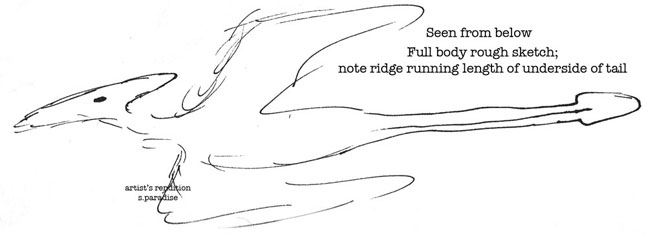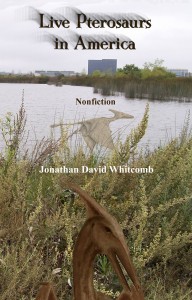By Jonathan Whitcomb, cryptozoology book author
Update on May 20, 2019:
The main part of this post (beginning with the sub-heading “Introduction” and written and published late in 2017) is now updated with more detailed estimates for the number of Americans who are eyewitnesses of a modern pterosaur. Please give more attention to this update and take the original paragraphs of this post in context with the following revision:
Encounters with actual living pterosaurs in the United States are now divided into three types:
- Great impression: The eyewitness tells one or more persons about the sighting, with a word like “pterodactyl” or “dragon” or “flying dinosaur,” etc.
- Moderate impression: The eyewitness thinks something like “pterodactyl” but either tells nobody or uses a weasel word or phrase like “strange big bird.”
- Poor view: The eyewitness sees no form or features that would identify the flying creature as a pterosaur (bioluminescence is a possible exception).
With only a relatively few exceptions, the third type is of practically no importance. The first type is most important, for those eyewitnesses generally report their encounters to more than one person, at least over the long run.
See “Additional Update” at the end of this post.
Introduction
As of early December of 2017, it seems that no scientist has a body of a recently-deceased pterosaur to examine, or at least I have no knowledge of such a discovery and examination. That’s why my associates and I continue to work in the realm of cryptozoology, using whatever knowledge is available.
The words and phrases Americans use for these featherless flying creatures can include the following:
- pterodactyl
- dinosaur bird
- dragon
- big bird with no feathers
- flying dinosaur
- prehistoric bird
An earlier estimate for the number of American eyewitnesses
On August 9, 2009, I published a press release: “Apparent Living Pterosaurs Seen By 1400 Americans, According To Author Jonathan Whitcomb.” Here’s the subtitle:
“A cryptozoologist estimates that at least 1400 credible eyewitnesses have seen, in the United States, over the past 29 years, large flying creatures unlike any known bird or bat: apparent pterosaurs.”
Notice that I left open the possible interpretation, in that subtitle, that a not-yet-discovered type of flying creature may live in the USA but have no ancestor that is closely related to any pterosaur of the distant past that is now known by its fossils. I have never subscribed to such an extremely unlikely interpretation; I just left open that possibility. In my view, if it looks like a pterosaur, and is very much unlike any bird or bat or kite or flying machine, it is a pterosaur. At least I consider it highly likely to be so, in any particular sighting.
Recent findings related to how many Americans have seen a living pterosaur
During the past eight years, however, as more eyewitnesses have contacted me with details about their encounters with apparent modern pterosaurs, it has become increasingly obvious that the original figure of 1400 is a gross underestimate. Why is that? Those pterosaur eyewitnesses who have also encountered other pterosaur eyewitnesses—those persons are more common than I had thought when I came up with “1400” in the year 2009.
Take the following report as an example:
Recently, a man from Albuquerque, New Mexico, gave me a phone call and reported what he and 20-25 other eyewitnesses encountered many years ago. In the summer of 1972, at dusk in an open field, they were talking and roasting marshmallows when the talking stopped. Near to those people flew a huge creature who wingspan was estimated to be 15-20 feet. It seemed to be covered with fur instead of feathers, and it had a long tail. The man who reported this to me is Arthur Ramirez.
This sighting has two points:
- Of the 20-25 eyewitnesses of this encounter in 1972, only one person has contacted me
- The man who reported it has found other persons with similar encounters at other times in N.M.
Here’s a second example:
Earlier this month, a man sent me an email about a sighting he had in Durham, North Carolina, in 1993. Dane Simmons saw the flying creature while driving. Twenty years later, he learned that two of his friends also had seen an apparent pterosaur and that sighting was only about three miles from where Dane had his encounter.
Here’s a third example:
In June of 2017, a boy and his mother saw a “dragon” while those two eyewitnesses were in their backyard in Draper, Utah. They soon learned that the woman’s brother had several sightings of that same flying creature earlier in the year. The family then learned about a friend who had seen one at about the same time that the woman’s brother had his sighting, but her encounter was a few miles to the east.
Example number four:
A few days ago, I got an email from a lady who had a sighting north of Atlanta, Georgia, in 1999. Years after that encounter, she was talking with a couple about it and learned that one of them had a sighting of a similar flying creature in that same area north of Atlanta. That other eyewitness, however, did not want to talk about it.
Other examples could be given, but it now appears obvious: Sightings of living pterosaurs in the United States are not rare, but those who report their encounters to me—they make up only a tiny fraction of the eyewitnesses.
.

Sketch by the American eyewitness Sandra Paradise (copyright held by her)
.
Conclusion on the number Americans who have seen a living pterosaur
As of mid-December of 2017, I still don’t have a firm handle on anything close to a particular number, for a variety of reasons, yet we can arrive at some reasonable maximum and minimum numbers. We need to be precise regarding the concept of an “encounter.” For the purpose of this blog post, I’ll set aside the general concept of encounters, which includes unreported experiences of hearing screeches but seeing nothing and seeing an obscure shadow fly overhead at night. Let’s confine our examination, for now, to sightings in the USA in which one or more persons observed an obvious pterosaur. This is the common idea of the phrase pterosaur sighting.
It appears obvious that less than a fourth of the human population of the United States has had such a sighting, otherwise I would be getting a number of emails or phone calls every day. It’s also obvious that the number of Americans who have seen an obvious pterosaur could not be less than 10,000, or I would not have received so many reports that include references to other eyewitnesses: friends and relatives and other acquaintances of the original eyewitness.
For the moment, we’ll have to be content with a general range. It seems that between 50,000 and 4,000,000 Americans have seen an obvious pterosaur at some time in their human lifespans. It certainly cannot be much below that minimum or much above that maximum. I hope that more eyewitnesses will choose to contact a cryptozoologist about their sightings. My associates and I need more data to work with.
Additional Update (written and published May 20, 2019)
We now have three categories of sightings: types one, two, and three. The first one is most important. These eyewitnesses were so impressed with their encounters that they informed other persons about it: usually family members, friends, or other persons. Other persons include government officials and cryptozoologists.
The first two types could total close to 150,000, and that is a conservative estimate. Only about a quarter of those, however (37,500) are type #1. In other words, of all the Americans now living in the USA, about one out of every 8,000 have had a clear-enough view of a living pterosaur to tell other persons that they saw such a flying creature. Yet only about 1% of those (~37,500) eyewitnesses report their sightings to me, Jonathan Whitcomb.
###
.
Although it’s more common, in the United States, for an eyewitness of an apparent living pterosaur to use the word pterodactyl, I sometimes come across the phrase “flying dinosaur.”
.
Cryptozoology and pterosaurs — in California, Texas, Florida, South Carolina, Ohio, New York, etc
.
People have been indoctrinated into dinosaur and pterosaur extinction for a long time in Western countries, so they assume it must be some kind of mistake when somebody reports observing a living pterosaur . . .
.
. . . this is my son’s interpretation of what he saw . . . He said it moved very fast like in stealth mode and was chasing one of the eagles or hawks around. He said it was 2-3 times the size of the bird it was chasing.
.
Jonathan Whitcomb — An active cryptozoologist, interviewing eyewitnesses of apparent living pterosaurs and analyzing and comparing testimonies
.
Not all mysterious lights appearing near Marfa, Texas, are car headlights on a highway. A few times each year the strangest lights appear, although they stay for only about one or two nights at a time.
.
Living pterosaurs of the world
I, Jonathan David Whitcomb, proclaim that not only are not all species of pterosaurs extinct but more than one species is living, and they range in extensive areas of the planet.
.
I saw a pterodactyl gliding over the campsite
Report of a pterosaur sighting in Spain
.



